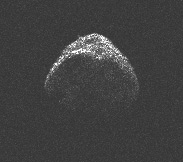Near-Earth asteroid twice as big as previously thought

On June 14, 2012, the asteroid 2012 LZ1 passed the Earth. It missed us by a wide margin, over 5 million kilometers (3 million miles), so there was no danger of impact. While it does get near us every now and again, using current orbital measurements we know we're safe from an impact by this particular rock for at least 750 years. Phew.
 Good thing, too. New observations using the Arecibo radio telescope in Puerto Rico indicate LZ1 is bigger than we first thought. Much bigger: it's about a kilometer across, when it was thought to be half that size before these observations.
Good thing, too. New observations using the Arecibo radio telescope in Puerto Rico indicate LZ1 is bigger than we first thought. Much bigger: it's about a kilometer across, when it was thought to be half that size before these observations.
That's a big difference. The problem is that the size of an asteroid is hard to determine. Even a big one may only appear as a dot in a telescope, so even though we may know its distance and trajectory very accurately, directly measuring its size isn't possible. Usually, the size is estimated by knowing its distance and how bright it appears. In general, a bigger rock will look brighter than a smaller one at a given distance.
But that assumes they both reflect the same amount of light. Most asteroids reflect about 4% of the sunlight they receive (this property is called the albedo), but that depends on their surface. Some have darker surfaces, some brighter. If you don't know how reflective it is, the size can only be estimated.
But the Arecibo telescope can actually directly measure the size of a nearby asteroid. It can send pulses of radio waves at an asteroid and then receive the reflected waves, much like a cop on the side of the road uses radar to measure a car's speed. The method is technical (Emily Lakdawalla has a great explanation on her blog), but it was used for LZ1 to get the new size measurement. The picture above is the actual image generated using Arecibo when the rock was still 10 million km (6 million miles) from Earth. Apparently, LZ1 is much less reflective than assumed earlier, which is why the size was underestimated by a factor of two.
An asteroid this size hitting the Earth would be, um, bad. That's big enough to be considered a global hazard, causing immense devastation. It might not be an extinction event -- the dinosaur-killing asteroid was 10 km across, so it had 1000 times the mass of LZ1 -- but it wouldn't be fun. So I'm glad we're safe from this guy for some time!
But I'll be honest: LZ1 was only discovered a few weeks before it passed us. Asteroids this size passing near us are pretty rare (we haven't had an impact from something this big for many, many millennia) so as usual I'm not panicking about this. But it just shows once again that we need more eyes on the sky, more people looking. And we need a plan in place in case we do see one with our name on it.
Related Posts:
- Asteroid 2011 AG5: a football-stadium-sized rock to watch carefully
- My asteroid impact talk is now on TED
- Another tiny rock will pass Earth tomorrow
- Updated movie of asteroid YU55, plus bonus SCIENCE
- Just to be clear: asteroid YU55 is no danger to Earth
- Armageddon delayed by at least a century⦠this time




























